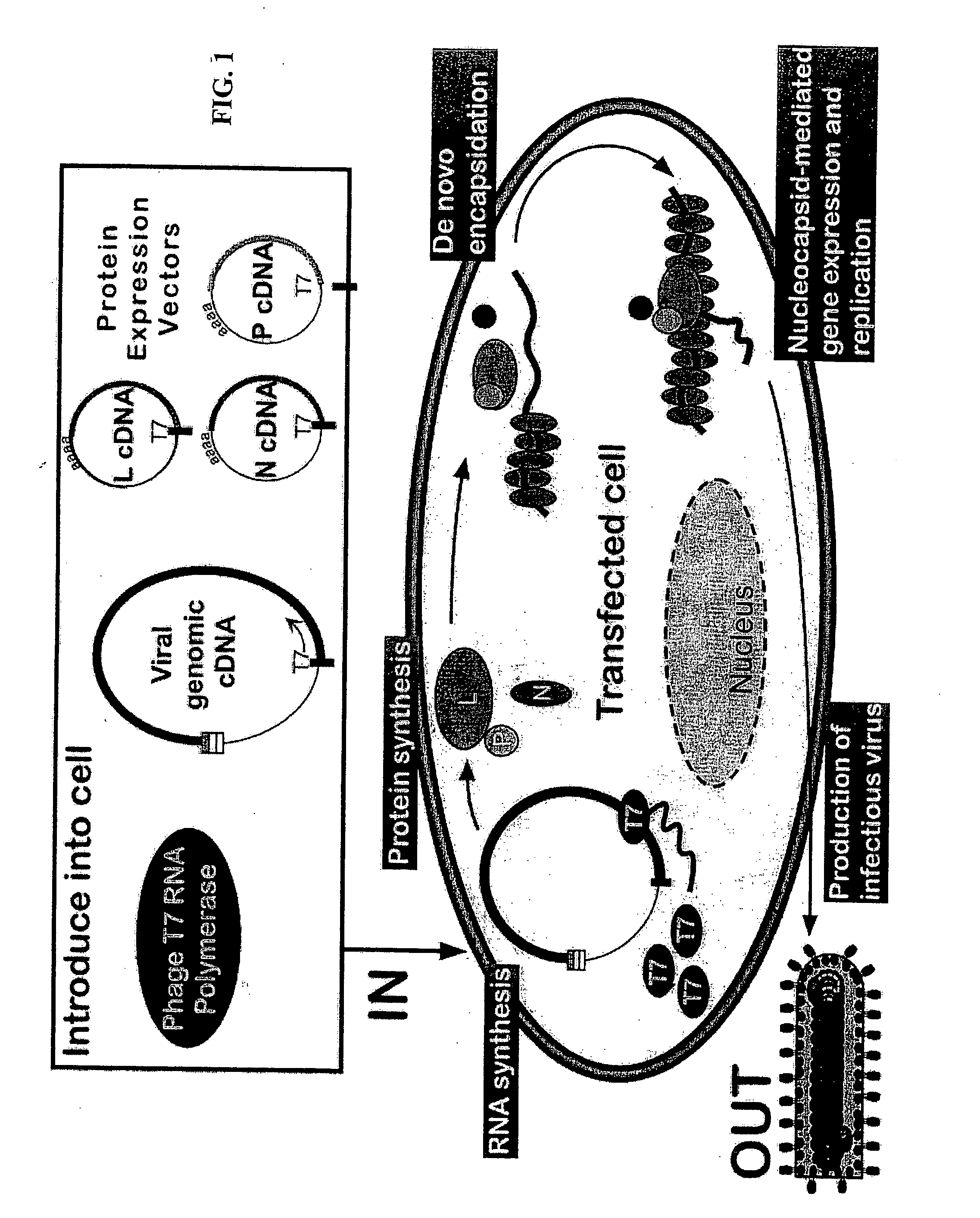Method for the recovery of non-segmented, nagative-stranded RNA viruses from cDNA
a technology of nagativestranded rna viruses and cdna, which is applied in the field of recovery of non-segmented, nagativestranded rna viruses from cdna, can solve the problems of unfavorable immune responses and/or response profiles, inability to effectively provide vaccines of any kind, and inability to effectively protect against viral subunits. , to achieve the effect of efficient recovery
- Summary
- Abstract
- Description
- Claims
- Application Information
AI Technical Summary
Benefits of technology
Problems solved by technology
Method used
Image
Examples
example i
General Calcium-Phosphate Transfection Protocol for Rescue of Non-Segmented Negative Stranded RNA Viruses From Vero Cells
Solutions
[0179] The following solutions are generally useful for host cell transfection:
[0180] A 2XBBS (per L) solution (2XBES-buffered saline) of 280 mM NaCl [16.4 g NaCl (or 56 ml 5M NaCl)], 50 mM BES [10.7 g BES (free acid form)], and 1.5 mM sodium phosphate [0.21 g Na2HPO4]. The BBS solution is adjusted to pH 6.95-6.98 with NaOH. The solution is then filter-sterilized and stored frozen.
[0181] A 2.5 M CaCl2 solution of 36.8 g per 100 ml total volume is prepared and stored at −20° C. The solution is filter-sterilized using nitrocellulose. Cellulose acetate filters are to be avoided because they clog. Alternatively, the transfection solutions are autoclaved for sterilization. However, the latter procedure may be less desirable, because the 2XBBS solution may change slightly during autoclaving.
[0182] The following solutions are generally useful for the mediu...
example ii
General Calcium-Phosphate Transfection Protocol for Rescue of Paramyxoviruses
[0193] The following alternative transfection procedure uses a calcium-phosphate transfection protocol based on the methods of Chen and Okayama, Mol. Cell. Biol. 7:2745-2752, 1987, incorporated herein by reference.
Exemplary DNAs:
[0194] 1. A full-length viral genomic cDNA clone containing a T7 promoter fused to the 5′ end of the positive-sense strand and a ribozyme fused to the 3′ end.
[0195] 2. Protein expression plasmids, controlled by a T7 RNA polymerase promoter, that encode the nucleocapsid protein (N or NP), phosphoprotein protein (P), and polymerase protein (L).
[0196] 3. A plasmid encoding the T7 RNA polymerase protein under control of the human cytomegalovirus immediate early transcriptional control region
Exemplary Calcium-Phosphate Transfection Reagents:
[0197] 1. 2×BES-buffered saline: 50 mM BES (pH 6.95-6.98), 280 mM NaCl, 1.5 mM Na2HPO4.
[0198] 2. 2.5 M CaCl2.
[0199] 3. Hepes-buffered sali...
example iii
Rescue of Measles Virus (MV) in Vero Cells
[0218] The exemplary transfection protocol described in Example 1, above, was used to rescue measles virus in Vero cells. The T7 source was either plasmid pSC6-T7 (without MVA) or MVA / T7 (Wyatt et al 1995). The results indicating numerous successful rescues (+) of MV are shown below in Table 3 (Columns A-F represent different rescue experiments performed on different days, with each experiment represented by multiple transfections—up to twelve separate transfections (wells) for experiments E and F).
TABLE 3Rescue of Measles Virus with Plasmid-T7 or MVA / T7ExperimentsWellABCDEFT7 Source1++−−−+MVA / T72−+−−++MVA / T73+−−+−+MVA / T74−−−−−+MVA / T75++−−−+MVA / T76−+−−−−MVA / T77−+pSC6-T78++pSC6-T79−+pSC6-T710−+pSC6-T711−+pSC6-T712−+pSC6-T7
PUM
| Property | Measurement | Unit |
|---|---|---|
| time | aaaaa | aaaaa |
| temperature | aaaaa | aaaaa |
| temperatures | aaaaa | aaaaa |
Abstract
Description
Claims
Application Information
 Login to View More
Login to View More - R&D
- Intellectual Property
- Life Sciences
- Materials
- Tech Scout
- Unparalleled Data Quality
- Higher Quality Content
- 60% Fewer Hallucinations
Browse by: Latest US Patents, China's latest patents, Technical Efficacy Thesaurus, Application Domain, Technology Topic, Popular Technical Reports.
© 2025 PatSnap. All rights reserved.Legal|Privacy policy|Modern Slavery Act Transparency Statement|Sitemap|About US| Contact US: help@patsnap.com



